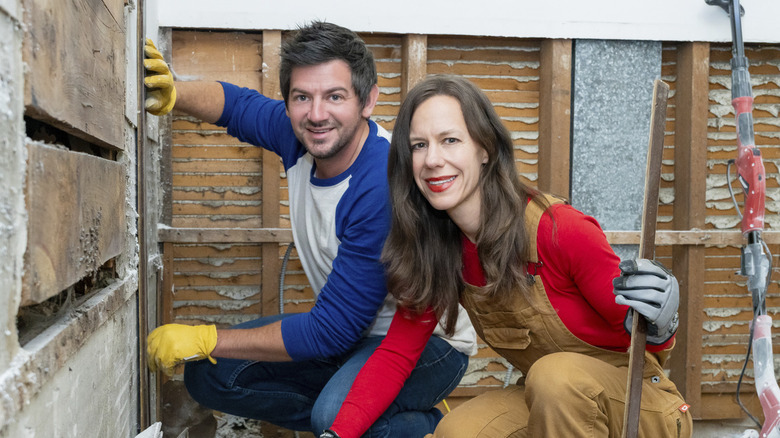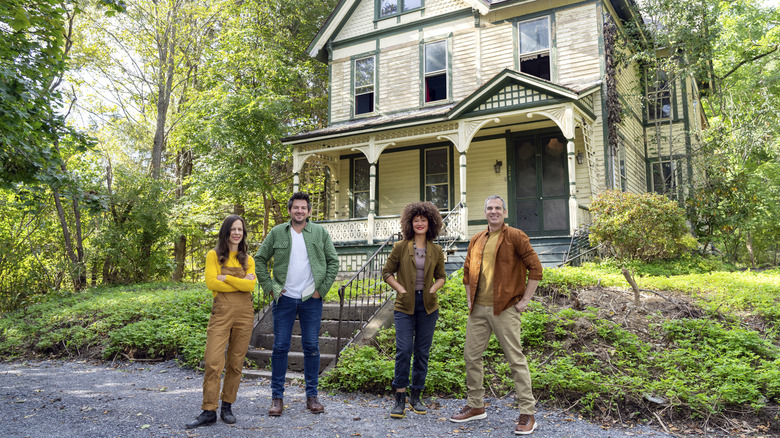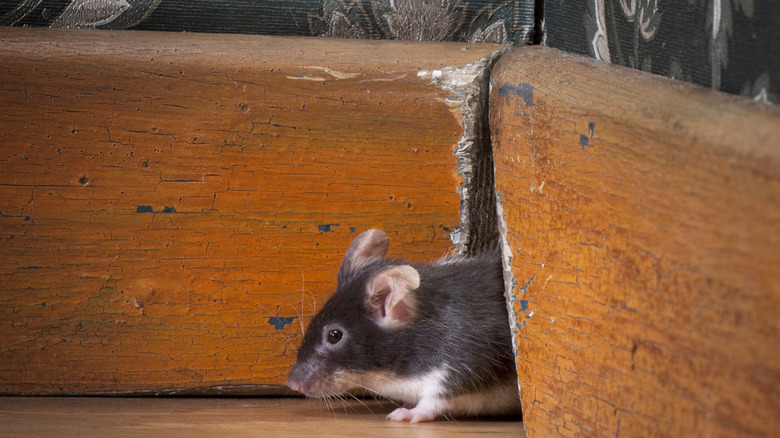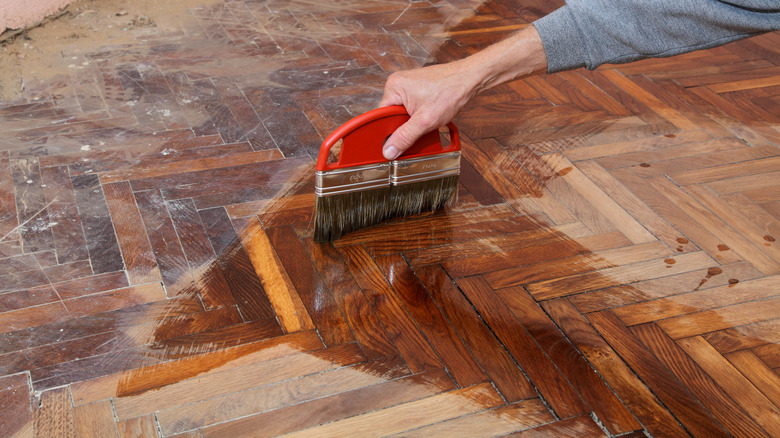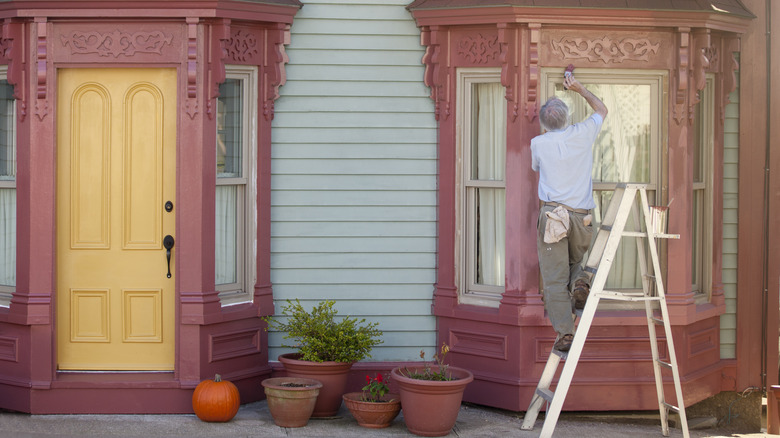Elizabeth & Ethan Finkelstein On The Joys & Pitfalls Of Renovating Old Homes - Exclusive Interview
Many people drive by a battered, neglected home and sigh at the mess, but for historical preservationist Elizabeth Finkelstein and her husband Ethan Finkelstein, these properties are brimming with potential. After launching the humble Instagram account "Cheap Old Houses" in 2016, the duo ignited a new wave of interest in these neglected homes from the past, and their fame has grown massively in the years since, for understandable reasons: With the housing market cutting down some people's dreams of ever affording a turnkey home, "cheap old houses" have become a necessity for many. And in going into these historic houses, Ethan and Elizabeth find that there is always a silver lining — often in the form of a surprise hardwood floor, a vintage chandelier, or a beautiful banister.
The duo and their fans now eagerly anticipate the release of their latest HGTV series, "Who's Afraid of a Cheap Old House?," which will highlight the selection and renovation of quirky old homes under $150,000. In an exclusive interview with House Digest, the Finkelsteins spoke more about their upcoming new TV series and shared some of their best tips for folks interested in buying and renovating a cheap old house themselves.
Who's Afraid of a Cheap Old House? Not the Finkelsteins!
To kick things off, how has the filming been for your new show and how will this series be different from your other show, "Cheap Old Houses?"
Elizabeth Finkelstein: Well, in our old show we did very much what our Instagram feed has done for years and years, which is to show people the possibility in cheap old houses and cheap old houses that are for sale. But then we started to notice that people were actually buying houses off of our feed, and then had questions about how to actually restore them. And people who were interested in buying cheap old houses were like, "Well, it's one thing to see this on an Instagram feed and it's a whole other thing to change your life and go buy it." So it's really fun that this new series is now the second part of that, which is showing people that it is absolutely possible and there are a whole bunch of people who did it and the rewards have paid off. This show is half about shopping for houses and half about actually restoring them and seeing transformations.
As you know, it's not just the beauty of these old houses that really draws people in. Sometimes it's the low prices, especially in this economy. Do you have a secret method for finding these cheap old houses?
Elizabeth: It's quite analog. It's us on a screen looking ... We read the entire internet every day. Also, we have a huge audience, a very active audience of people who are sending us listings constantly. Truly what we're looking for is character. We would rather have a house have a little bit of deferred maintenance than have one where someone has come in and stripped everything valuable from it, flipped it, and made it look like a builder grade brand new house. We're always looking for that diamond in the rough that has the character that can be put back, that can be restored, and somebody with vision, who feels that this might be their ticket into a housing market. [It's] actually a beautiful, wonderful ticket that can give them purpose and can make them feel like they're contributing to a community.
Ethan: For someone who's looking to actually purchase one, I think you want to look at the infrastructure [first]. If you can know that the roof is good and it can buy you five years before you start really renovating, you know that you're not going to have a lot of water issues ... If you're starting out with a [poor] foundation or roof, just know that it's going to add extra infrastructure expenses. It's nice to also know if you have a bathroom or heating. In our first season, we filmed in a lot of houses that had no heating at all. A lot of these cheap old houses come with issues, and it's just good to know what you're getting into and bring someone who might know something before you really dive in. But on the flip side, this is the most life-changing and amazing experience ever. We advocate for people to become debt-free and to actually be able to purchase a house for a really affordable price, and maybe not have a mortgage, or maybe have a small renovation loan. So, it can really be a house hack to get people into the housing market in a way that maybe is almost cost-prohibitive in many cities around the country.
Take on renovations one bite at a time
You had mentioned some of the hidden issues and surprises that can come with these old houses. Do you feel like pests can be a major problem?
Ethan: It's funny that you say that. I guess we found a snake in our walls, and then I think there's beetles, certain kind of beetles. I think mice and squirrels, and other rodents can be quite damaging to wires.
Elizabeth: These are not specific, though, to old houses. I think new houses also need maintenance. New houses also have pests. New houses also leak. In fact, I think the way that older houses were built, if they are maintained, prohibit a lot of more of that than some of the newer houses that are built with cheaper materials. I think pests are an issue in all homes, not just specifically old houses.
Ethan: What we find when we have a house that has maybe some of these issues, is that the old growth timber is so much [higher] quality that you're not really replacing it because it's not chewed through or rotted completely in many cases. So that old structure is helping you continue it further for so many more years.
Even for homes that don't have a pest issue, it can still be a lot of work to take on a renovation by yourself. Do you usually recommend that people hire a contractor or try to do the bulk of the work themselves?
Elizabeth: I think there's a lot of things you can do yourself, and I think in this day and age we're very lucky to have so many resources available online to teach you how to do some of those things. That said, we are not people who say you must DIY everything or you've somehow failed. I don't think that's necessarily good for the house. There are certainly people out there that have the time and skills to be able to devote to learning very large things, but we certainly think that you should put together your priority list and go through it slowly, and do things well, and pay people when you need to be able to do them. Not only is that better for the house at the end of the day and better for your sanity, but it also supports the local economy. It gives to people, to tradespeople and craftspeople, and allows them to continue to work. And that's a very big part of restoring cheap old houses, in our opinion — what it does for the local community.
Ethan: Getting good at something and learning some of the processes of homeownership while you're in renovation or restoration is amazing because then you can continue those processes and have so much more confidence past your initial purchase date. And it's just so much more freeing to be like, "Oh, I could change out this light fixture," or "Oh, I could change this plumbing fixture," or "I could replace this." These old houses are pretty strong and they're not going to crumble on you if you're messing around. But don't take out any supporting beams and stuff.
Cherish and protect your old floors as much as possible
One of the most rewarding parts of any renovation is getting to uncover all of those old details and features. One detail which people really love is the floors. Do you guys do the best you can to salvage an old floor in every house, and what do you do to refresh them and make them feel new?
Elizabeth: Every single time. Making things feel new? Making things feel new is not necessarily what we're about. I think we want it to feel old. We want it to feel like it has the character. And oftentimes the challenge with old floors is [to avoid] over-restoring it to the point where it looks like a brand-new floor. And so how do you keep it that way? One [way] is by sourcing old lumber, so it has that wear and tear, of feeling like it's been there forever. That's what we just did in our house. We sourced old wood and put it in. But yeah, absolutely. We are 100% pro restore your old floors.
Ethan: So, you'll see on a few of the episodes, we rip up carpet, we rip up subflooring that's over the original flooring. We rip up vinyl. In some instances, there's three or four layers of material, and then we're exposing the original woodwork, which is just so amazing. Then what we do is we come and sand, and prep the floor for a nice new look and then stain it. Typically, we try to stain it with something that's appropriate for the wood species or the space and the interior design aesthetic. We don't typically do color dye staining for a different color, but we'll do something that might be a wood color or something natural, and then you can layer on top of that with carpeting if you want to have that warm experience.
Elizabeth: Rugs. Really love rugs.
Ethan: Antique rugs, exactly. Just any little rugs to keep you warm in the winter months.
If the floors can't be salvaged, is there a specific type of new flooring that you usually recommend to retain some of that character?
Elizabeth: If the floors can't be salvaged, a lot of times what they would do historically is they would paint them, if the floors were rustic or not able to be restored perfectly, they could paint them. We always love natural materials because they can be fixed. If you're putting something like a plastic or a prefab material on your floor, when it goes, you have to throw it in a landfill. We do feel it is worth investing in a natural material for your windows, for your floors, for everything, because it can be patched and fixed and restored time and time again, which ultimately will make it more sustainable at the end.
Ethan: I think we always advocate for, if it's possible, if the floor is not completely rotted, you can layer on top. We don't typically do that ourselves, but if you don't harm the building, then leave it for someone else to do. I think you can layer on top, and it would be totally fine for the historical character of the house, if that's not what you're into — if you're looking for a splinter-free, scratch-free experience. We're into authentic stuff.
Elizabeth: We like splinters over here!
Historical color schemes don't have to box you in
Speaking of paints, do you feel like there are any specific shades of paint that enhance the natural features of a home? Where do you like to look for color inspiration?
Elizabeth: We love color. I think one of the big things about old houses is they often would use more flat [paint]. It's the sheen of the paint I think makes a big difference when you're looking at old houses, especially because oftentimes plaster walls are a little bit uneven, so doing anything shiny on them will bring that out more. So thinking about leaning into flatter sheens is definitely a good thing. Honestly, a simple Google search for an era of a house will bring up color palettes for an era that will feel appropriate in a house. A lot of people think old houses have to be muted colors or a little bit stodgy, and no, there was a vibrant range of colors throughout all of these things. Thomas Jefferson's dining room was chrome yellow. There is a lot of color in history that's really, really fun, and we absolutely love the use of color and love the use of paint as a really great, quick and easy way to transform houses.
That's all the questions I have for you today. Is there anything else you can tell us about your upcoming premiere?
Elizabeth: Tune in! Tune in! If you love old houses and you're excited for the opportunity to see them have a moment on the small screen, respected and not torn apart. This is the show for you.
Ethan: I think what's really cool about our show too, is that there's such a wide range of aesthetics and historical moments in the show. There's a firehouse, there's a church. The firehouse is brick, but the church is wood. There's a stucco house that reminds you of a craftsman or bungalow house.
Elizabeth: It's for everybody, and it just goes to show that you can find your place in the world of old houses. There's so much personality and variety in them, that there really is one for everybody.
"Who's Afraid of a Cheap Old House?" Premieres on HGTV on May 14 at 10 PM ET/PT.
This interview has been edited for clarity.
